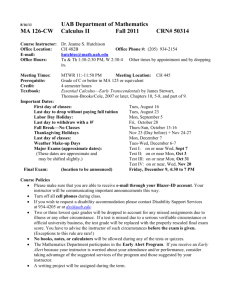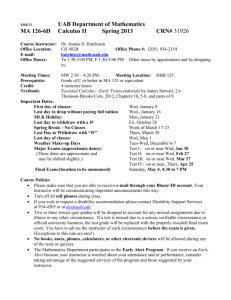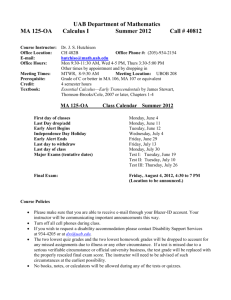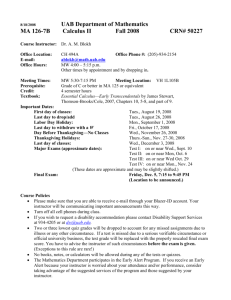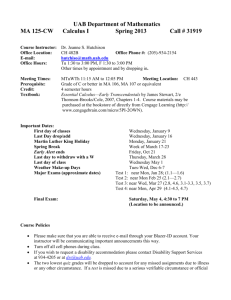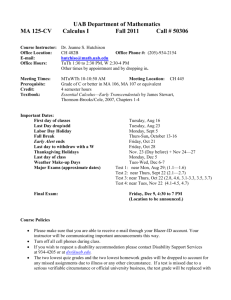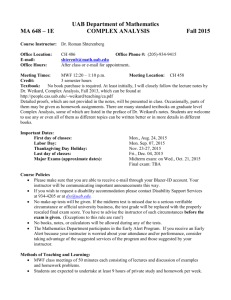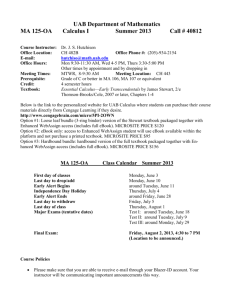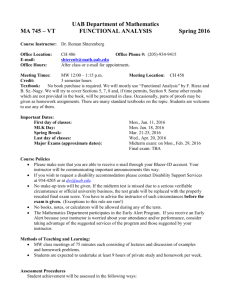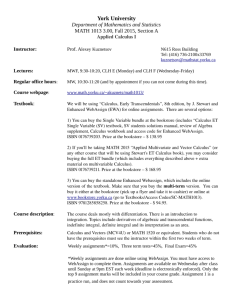UAB Department of Mathematics
advertisement
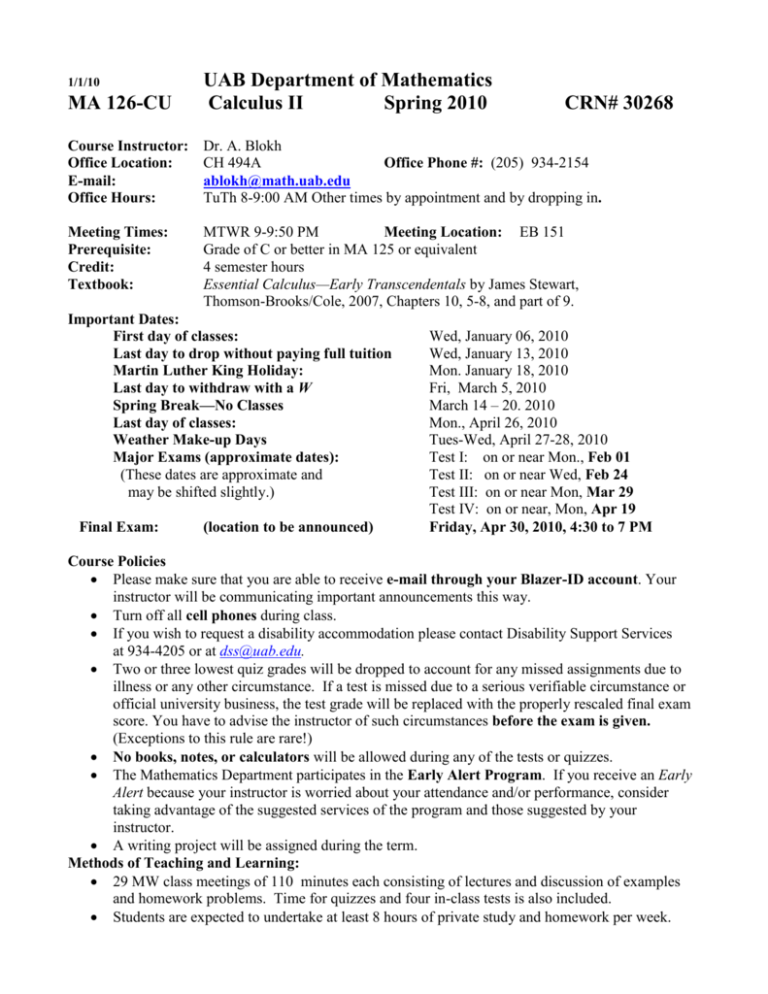
MA 126-CU UAB Department of Mathematics Calculus II Spring 2010 Course Instructor: Office Location: E-mail: Office Hours: Dr. A. Blokh CH 494A Office Phone #: (205) 934-2154 ablokh@math.uab.edu TuTh 8-9:00 AM Other times by appointment and by dropping in. Meeting Times: Prerequisite: Credit: Textbook: MTWR 9-9:50 PM Meeting Location: EB 151 Grade of C or better in MA 125 or equivalent 4 semester hours Essential Calculus—Early Transcendentals by James Stewart, Thomson-Brooks/Cole, 2007, Chapters 10, 5-8, and part of 9. 1/1/10 Important Dates: First day of classes: Last day to drop without paying full tuition Martin Luther King Holiday: Last day to withdraw with a W Spring Break—No Classes Last day of classes: Weather Make-up Days Major Exams (approximate dates): (These dates are approximate and may be shifted slightly.) Final Exam: (location to be announced) CRN# 30268 Wed, January 06, 2010 Wed, January 13, 2010 Mon. January 18, 2010 Fri, March 5, 2010 March 14 – 20. 2010 Mon., April 26, 2010 Tues-Wed, April 27-28, 2010 Test I: on or near Mon., Feb 01 Test II: on or near Wed, Feb 24 Test III: on or near Mon, Mar 29 Test IV: on or near, Mon, Apr 19 Friday, Apr 30, 2010, 4:30 to 7 PM Course Policies Please make sure that you are able to receive e-mail through your Blazer-ID account. Your instructor will be communicating important announcements this way. Turn off all cell phones during class. If you wish to request a disability accommodation please contact Disability Support Services at 934-4205 or at dss@uab.edu. Two or three lowest quiz grades will be dropped to account for any missed assignments due to illness or any other circumstance. If a test is missed due to a serious verifiable circumstance or official university business, the test grade will be replaced with the properly rescaled final exam score. You have to advise the instructor of such circumstances before the exam is given. (Exceptions to this rule are rare!) No books, notes, or calculators will be allowed during any of the tests or quizzes. The Mathematics Department participates in the Early Alert Program. If you receive an Early Alert because your instructor is worried about your attendance and/or performance, consider taking advantage of the suggested services of the program and those suggested by your instructor. A writing project will be assigned during the term. Methods of Teaching and Learning: 29 MW class meetings of 110 minutes each consisting of lectures and discussion of examples and homework problems. Time for quizzes and four in-class tests is also included. Students are expected to undertake at least 8 hours of private study and homework per week. The on-line homework system Enhanced WebAssign will be used. More information follows on this. Aims of the Course: Upon successful completion of the course, a student understands the concept of a vector, can perform basic vector calculations, and is able to use vectors to describe lines and planes in space; understands the concept of vector-valued functions, and is able to use vector functions to describe parametric curves, tangent vectors and velocity; understands the concept of a definite integral; is able to apply the definite integral to find volumes, work, arc length, etc;; is able to apply the concepts of calculus to problems in physics and engineering such as center of mass, moments, etc; is able to determine the convergence/divergence of improper integrals, sequences, and infinite series; and can find power series representations of functions and use them for approximation, evaluation of integrals and limits, etc. Course Content: Vectors in three dimensions, their geometric and algebraic representation, dot product and cross product Equations of lines and planes Vector-valued functions and parametric curves, tangent vectors, velocity, and speed Riemann sums, the definite integral, area, and distance The fundamental theorem of calculus Basic techniques of integration (substitution, integration by parts, partial fractions, use of tables) Applications of integration (area, volume, arc length) Applications to physics and engineering Sequences and series, power series (Taylor/Maclaurin series) Assessment Procedures Student achievement will be assessed in the following ways: a. Regular online homework.. Homework will be due approximately one week after assignment. Feedback is provided when wrong answers are given. Students are encouraged to retake the assignments (with randomly changed parameters) until they obtain correct answers. An unlimited number of takes is allowed during the week in which the set is available. Homework contributes 10% to the course averages. Problems on tests are modeled after homework problems and quizzes. Staying on top of on-line homework, as well as the daily practice problems, is therefore extremely important. b. Sporadic unannounced quizzes. Quiz problems are modeled after homework problems (on-line ones and daily practice problems). This allows students to gauge whether they are ready to work problems in a test situation. Quizzes contribute 6% to the course average. c. Four 50-minute tests in class including short questions for which little or no credit is awarded (Part I) as well as problems requiring in-depth understanding (Part II) for which partial credit is awarded where appropriate. Each test contributes 12% to the course average. d. A project assigned during the term. The project contributes 6% to the course average. e. A 150-minute comprehensive final examination including Part I and Part II type problems. The final exam contributes 30% to the course average. . TIPS Your course performance is your course average (including the final exam score). This is a number between 0 and 100. Your final grade is determined according to the following table: Course performance 88-100 75-87 62-74 50-61 Below 50 Final Grade A B C D F In addition, your grade may be raised by a strong performance on the final exam (normally at most one letter grade. Help is available in the Math Learning Lab, HHB 202. The exact schedule will be posted On the math website www.math.uab.edu. Special times when tutors dedicated to calculus will also be announced. Darryl White is always there though Mon-Fri 9-5 at the desk at the entrance, and he can answer calculus questions. Past exams given in Calculus II are posted on the math website www.math.uab.edu for student practice. Click on Test Bank. Regular class attendance, working steadily and regularly, and seeking help when needed will all increase your chances to succeed in this course. Remember that being a full-time student is a full-time job. How to get started on Enhanced WebAssign (the on-line homework): (1) Go to www.webassign.net and click on I Have a Class Key in the signin link. (2) Enter the following course key: uab 8293 2350 and proceed. (If prompted for your institution, enter uab) (3) When prompted to purchase an access code, select… “trial period”. (Do not purchase an access code at this time. However, you must purchase an access code within two weeks for you to continue using the system beyond the two week trial period. The system will prompt you to enter your access code when the deadline approaches. (Your book may have an access code bundled with it. You must use it.) (4) After your first registration, you can sign in as a returning user. (5) Should you run into technical problems Enhanced WebAssign provides technical support online and/or by phone. Sections to be covered: Essential Calculus—Early Transcendentals by James Stewart, ThomsonBrooks/Cole, 2007 Chapter 10: 10.1 – 10.5, 10.7, (related section: 9.1) Chapter 5: 5.1– 5.5 Chapter 6: 6.1-6.3, 6.6 Chapter 7: 7.1 – 7.5, 9.2 and 10.8 (related section: 7.4) Chapter 8: 8.1 – 8.7 Common Courtesies for Any Class: Putting your head on your desk resting or sleeping during class is rude. If you need to sleep, please go to your room or home – not to class. If you need to leave class early, it is polite to tell the instructor before the class starts. Class attendance is expected. Please arrive for class a few minutes early so that class can begin without interruption. If there is a problem, let the instructor know.
